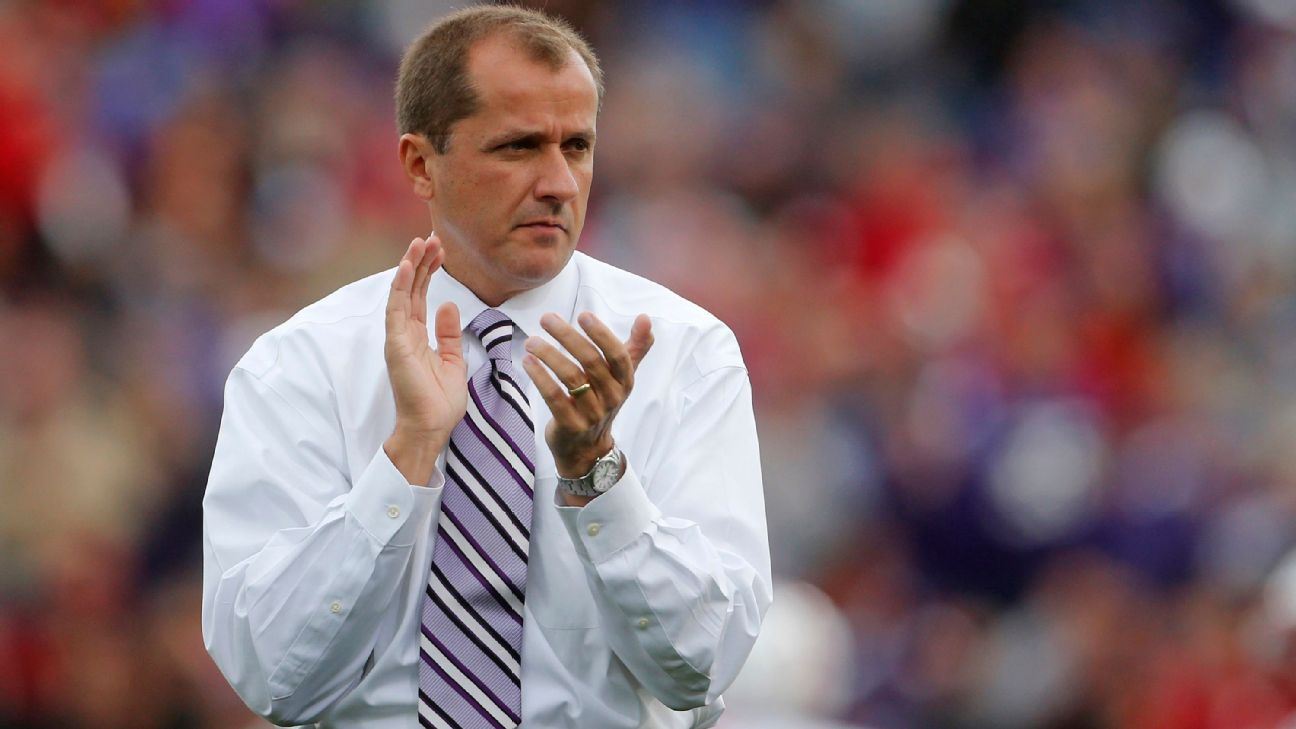Since officially taking over as ACC commissioner last month, Jim Phillips has spent much of his time getting to know people within the league. He likes to ask about family, saying it’s a good way to connect. He is trying to build trust, get a lay of the land and absorb feedback from coaches and administrators on what he should prioritize.
Those within the ACC have been blunt with their assessments.
Given this pivotal moment for the conference, ESPN talked with 16 athletic directors and football coaches from across the league in recent weeks. Each one of them believes Phillips is the right man for the job, but they also know his influence could have ripple effects throughout the sport for years to come.
That is because the ACC’s different financial trajectory compared to other Power 5 conferences leaves the new commissioner with a daunting task. Bringing in more money is a must, but to do that, the ACC must prioritize football and rewrite the league’s image. To get there, Phillips’ constituents will seek his guidance in the process, from reconsidering scheduling to divisional alignment, TV deals to expansion, and the league’s long-term relationship with Notre Dame.
As Phillips gains valuable information and feedback to bring back to athletic directors, decisions can be made about how to approach its biggest football questions. At least for now, multiple athletic directors said, “Everything is on the table.” But before any decisions can be made, Philips himself needs to do some evaluating of his own as he works on creating a blueprint for the ACC’s future.
“Is it strictly just money [holding teams back]?” Phillips said during a recent telephone interview with ESPN. “Or have we not recruited as well? Or do we need some additional help from a support staff standpoint? Yes, revenue is a huge part of it, but are we scheduling accordingly? Do we have the right matchups? Are we playing in the right venues? Can we create our events that are one-offs that allow us to take some of our games to different places for interest and potential additional revenue generation?”
There is no shortage of answers, but the following are the consistent set of challenges that surfaced after speaking with those within the conference.
Relevance within the Power 5
On the football field, the league has become Clemson and everyone else, with the Tigers winning the conference six straight seasons, while signature brands such as Florida State, Miami and Virginia Tech have lagged far behind. The ACC also distributed a little more than half the revenue of what the SEC sent its member schools for the 2018-19 season, and that gap figures to grow unless the ACC can somehow convince Notre Dame to join as a full-time member.
The SEC and Big Ten remain the dominant financial forces in college football. From TV deals, merchandising, league championship games and bowl revenue, the two conferences sent member schools about $45 million and $54 million, respectively, in 2018-19 (the last year for which data is publicly available). The ACC, meanwhile, distributed at least $27 million to each school that year.
The Big 12 distributed an average of $37 million to its 10 schools, which represented a small decrease from the previous year. The futures of its TV deals, including the Longhorn Network, represent a clear inflection point on the horizon that has led some athletic directors to again ponder the possibility of another round of conference realignment, which nearly toppled the Big 12 a decade ago.
The Pac-12 saw a small increase in total revenue for 2018-19 and distributed about $3 million more per team than the ACC, despite failing to place a team in the College Football Playoff for four straight seasons and commissioner Larry Scott stepping down in June. While the league has had its own concerns over revenue and its struggling TV network, one Pac-12 administrator suggested there was obvious room for growth, while the ACC had flatlined. A number of ACC coaches and athletic directors who spoke to ESPN for this story agreed with that assessment.
“If we don’t get our TV contract in the ballpark of [the SEC and Big Ten], there will be no level playing field in the Power 5,” said one ACC coach, who spoke on condition of anonymity. “There will not be a Power 5 anymore, in my opinion.”
Syracuse football coach Dino Babers likened the situation to a track meet.
“You’re about to run a 4×100 relay, and you’re Leg 1,” he said. “You’re coming out of the blocks, your head is down, you’re pumping your arms. You slowly raise up and see someone already on the curve, which means your A-S-S is really far behind. That’s how I feel when we’re chasing the SEC and Big Ten when it comes to money.”
There’s no time to wait, Babers said. Closing in on the fastest runner requires an all-out sprint, and every debate over a step forward by ACC members puts the league further behind.
Meanwhile, Babers said, the SEC and Big Ten have a goal of their own: “Never let [the ACC] run them down.”
The league cannot afford to be passive after watching its closest geographic rival improve its fortunes once again.
The SEC just negotiated a new 10-year deal with ESPN that will further increase its revenue starting in 2024. Although terms were not disclosed, multiple outlets reported the deal is worth about $3 billion. The Big Ten’s current deal, meanwhile, goes through the 2022-23 season, and it will likely get a new, more lucrative television contract long before the ACC’s current contract is up (2036).
The ACC does have a check-in window on its television contract with ESPN this spring, and although the discussions between the league and network are not expected to drastically alter the current contract, Phillips views the discussions as valuable. Multiple athletic directors talked about the looming look-in window, believing everything should be on the table to help enhance the football product and make the league more attractive to TV partners.
The conference isn’t immune to financial woes caused by pandemic
In the wake of the COVID-19 pandemic, schools in any conference are feeling a serious financial pinch and have either cut non-revenue sports or furloughed or downsized athletic staff, and are borrowing against future revenue to make ends meet.
At Virginia Tech, AD Whit Babcock said the athletic department took in about $47 million less revenue than expected for fiscal year 2021 because of huge losses in ticket sales and canceled events, like the NCAA basketball tournaments. Because Babcock was able to cut costs, he expects the final numbers will show the Hokies lost about $15 million. With some schools forced to take out loans against future earnings, shelve planned projects or make dramatic staff cuts, Virginia Tech’s shortfall might comparatively be a success.
“We have 15 teams all pulling into the pits, and we’re all beat to heck,” Babcock said, using an auto racing analogy to explain the league’s financial position amid the COVID-19 pandemic. “Some have $20 million in damage, some have $40 million, but we’re all under water. The next race is how we come out of the pits.”
Another ACC athletic director offered similar thoughts on spending. Sure, the SEC has more money coming in, he said, but several SEC schools are spending that revenue before the checks have cleared. A smarter approach to spending — investing in assets with a financial return over gaudy new facilities, avoiding massive buyouts after bad coaching hires — can help offset some of the gap between the ACC and the SEC, he said.
“Everyone’s thought for a long time that our league trended toward the bouncy ball rather than the pointy one. … Has our league ever really looked at pushing football as the future?”
An ACC football coach
Those smaller changes may all have a cumulative effect, but they also underscore an obvious problem facing the league: The ACC simply doesn’t have the broader football success to leverage TV partners or sell out massive stadiums routinely. Clemson is running laps around the rest of the league, and just as the ACC Network got off the ground, marquee teams Florida State, Virginia Tech and Louisville finished a combined 12-19.
And with men’s college basketball powerhouses Duke and North Carolina being close to the ACC’s base in North Carolina, some coaches and administrators have long suggested it skewed the league’s priorities away from football, which provides the overwhelming bulk of revenue.
“Everyone’s thought for a long time that our league trended toward the bouncy ball rather than the pointy one,” one coach said, “but college basketball is not what it was as a franchise 10 years ago. Does that hurt us? Has our league ever really looked at pushing football as the future?”
Phillips doesn’t see it as a zero-sum decision but suggested the ACC must prioritize its biggest revenue stream across all schools — football.
“We can have it all,” Phillips told ESPN. “We’ve had our moments in the ACC, but we all want to see more sustained excellence because those two sports are important to the commitment we have as a league.”
Nearly all of the athletic directors and coaches we spoke to suggested the massive gaps in revenue present extensive challenges for their schools, affecting the ability to retain assistant coaches, hire support staff and placate fans and boosters when the SEC and Big Ten have far deeper pockets.
“I’m under no illusion that we’re going to close the gap and catch up with the SEC or Big Ten,” another ACC AD told ESPN. “I’m optimistic that we can maintain the gap at the same level of increase that the SEC just got and what the Big Ten will get in their next go-round. If we cannot let the gap get bigger and can cut into the gap in some other ways, that will be success to me.”
But there is not yet a consensus among the league’s athletic directors on the right strategy.
“I don’t know that there’s any one thing that you say, ‘This is the golden egg right here that’s going to change everything,'” Miami athletic director Blake James said. “But I do think we have to be willing, as a league, to look at everything, and working with our television partner and figuring out what’s the best way to position the ACC going forward.”
Everything is on the table
To truly move the needle, many within the conference believe the ACC needs to think big, and that inevitably moves the talk back to a place it was nearly a decade ago with conference realignment.
And a few COVID-19-inspired tweaks from 2020 offered some insight to options.
First, the ACC brought Notre Dame into the fold for a one-off season amid COVID-19 cancellations. A league member in all sports but football, the Irish needed the ACC to be able to play a full football schedule during the pandemic in 2020, and there are some inside the ACC still upset the league did not use its leverage to bring Notre Dame in as a full-time member.
“We had the perfect ultimatum last year,” one coach said. “We had them, they had nowhere to go. What would they have done? Why would we do that? Because we know that’s our lifeboat out from where we’re at right now. And to be honest, is that not Notre Dame’s lifeboat? Can they survive if the Big Ten and the SEC start lapping everybody? Instead, we just let them run through the front door, take all of our stuff and run out the back.”
As a non-football member of the ACC, Notre Dame’s payout from the league combined with its NBC TV deal added up to about $22 million for 2018-19, less than full-time ACC programs, so the Irish certainly increased their TV revenue as a full member in 2020. But Notre Dame remains adamant about independence, meaning little real movement has occurred behind the scenes. Notre Dame’s TV deal with NBC is up in 2025, and discussions around a possible playoff expansion that could reward conference champs means the incentive structure could change.
The ACC also played more league games — 10 were scheduled for each team, up from the standard eight — and scrapped the divisional format. The result was a larger inventory of quality matchups and two teams that made the Playoff, Clemson and one-year visitor Notre Dame. Discussions surrounding an enhanced league schedule or scrapping divisions are not new, but 2020 offered a litmus test. Perhaps that is why ACC athletic directors are already talking for the first time in years about reimagining divisions (Scrap them? Reconfigure them?) and scheduling as a way to enhance their product.
“There’s a longer play to this thing, but what in the immediate can we try to get focused on?” Phillips said. “What does the ACC look like with 14 football-playing schools and Notre Dame playing five in that mix? Where do we have some opportunities to grow that revenue, including distribution and getting out into households that we haven’t, in a format that allows people to watch us? I don’t think there are any exact or right answers right now, but I’m cautiously optimistic about where we can go in this look-in.”
Still, many coaches said they liked the divisional format because it made for predictable matchups, and programs such as Georgia Tech and FSU, that play a rivalry game against the SEC each year, are reluctant to add another conference game to their slate, potentially losing out on an easy win, making bowl eligibility more difficult, and missing the gate revenue from an added home game. Many ADs and coaches are skeptical there are enough votes to change now; even if the ACC scrapped divisions, it still would need to petition the NCAA for permission.
“Moving away from what we currently have just to move doesn’t make a whole lot of sense,” said Clemson athletic director Dan Radakovich, who remains a proponent of an eight-game league schedule because of its annual rivalry game with South Carolina. “If there’s value for us to go to a different format, then that needs to be discussed given that value proposition. We’re going to pay you X-plus if you do something different. OK, let’s evaluate the ‘X-plus’ and the ‘something different.'”
What has been good for Clemson, however, hasn’t necessarily been good for the rest of the ACC, and some coaches and ADs have lamented the elephant in the room — or, at least, in the Atlantic Division — and suggested a shake-up is in order.
“Those types of conversations can all be had as we look to evolve and really take the best of what we learned from last year and try to figure out, ‘OK, how do we massage this to make it good going forward?'” another ACC athletics director said.
Several athletic directors mentioned the Texas Longhorns, along with Big 12 rival Oklahoma, as another potential option to closing the gap with the SEC and Big Ten.
At this point, the conversations are mostly theoretical, but as the smallest and most geographically homogenous league, the Big 12 was a ripe target during the last round of conference realignment a decade ago, and is now looking at its own uncertain future with a new TV deal on the horizon and the shaky status of the Longhorn Network. That could make the Big 12’s biggest brands — the Longhorns and Sooners — a perfect solution for the ACC or Pac-12’s revenue woes and instantly transform an expanded conference into a bigger player in TV negotiations.
But Texas has outsized control in its own league along with a seemingly endless revenue stream, and past dalliances with the Pac-12 ultimately amounted to nothing. Could that change down the road if TV money and playoff expansion dominoes fall the right way? It was a common enough theme among ACC ADs to assume Phillips will at least do his due diligence.


